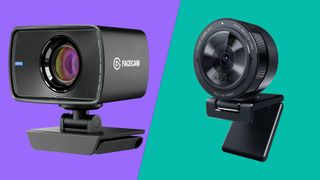Razer Kiyo Pro vs Elgato Facecam: which webcam is best?
Is there an ultimate winner in the Razer Kiyo Pro vs Elgato Facecam faceoff?

The Razer Kiyo Pro and the Elgato Facecam have been battling it out for some time now to take that coveted ultimate webcam title. But, while it might look like the pricier, more feature-rich Razer Kiyo Pro has it in the bag, the more important question is, “which webcam is best for you?” And, the answer to that isn’t as simple as it seems.
When it comes to the best webcams, it’s more about what you’ll need it for more than anything else. Anybody can benefit from getting the absolute best laptop on the market, for example. After all, we all have ever-changing, ever-expanding computing needs. But, when it comes to webcams, most of us won’t likely need anything more than an affordable or even cheap webcam because our needs aren’t likely going to evolve from video-conferencing with co-workers and video-calling loved ones daily.
Of course, with these two premium models, it is slightly different. If you’re here trying to figure out the differences between the two, you’re likely already in the business of creating online content (whether that’s streaming, making high-quality YouTube videos, or making money off of TikTok) or thinking about it. And, you’re looking into a high-resolution webcam with features that would be most useful for such an undertaking.
Still, the original premise is the same. The most ideal one for you isn’t necessarily the one at the absolute top. Both the Razer Kiyo Pro and the Elgato Facecam have their own strengths and weaknesses, after all. Luckily, we’re here to break it all down as we’ve used, tested, and reviewed both webcams ourselves.
In the case of Razer Kiyo Pro vs Elgato Facecam, here’s everything you need to know before deciding on a verdict.
Razer Kiyo Pro vs Elgato Facecam: Price and availability
- The Razer Kiyo Pro is little pricier
- The Elgato Facecam is better for money-saving consumers
Razer Kiyo Pro’s wallet-whimpering $199.99 (£199.99, AU$329.95) isn’t exactly for the budget-minded, and already that makes a massive difference to some people. That isn’t to say that Elgato Facecam’s $169.99 (£189.99, AU$299.95) price tag is much kinder to your bank account. In fact, we’d put both in the premium price range. But why spend $30 more on a webcam that might not be the most ideal for you?
Although on the flip side, $30 isn’t that much more if you’ll benefit more from the Kiyo Pro’s features like autofocusing, variable field of view, and HDR support – features that the Facecam doesn’t have.
We’re not trying to be evasive here, merely pointing out that it’s a matter of perspective (and again, your needs). However, if it’s just a matter of saving as much money as possible, the Elgato Facecam has the advantage.
Winner: Elgato Facecam
Razer Kiyo Pro vs Elgato Facecam: Design

- The Kiyo Pro is heavier
- The Elgato Facecam’s cuboid design is more unique
We love the spherical design that Razer has adopted for its webcams. At the same time, we also appreciate the Elgato Facecam’s cuboid design with its rounded corners, rounded sides and concave anterior that give it a much more interesting look. But, last time we checked aesthetics is still a matter of personal taste, for the most part, so we’re leaving it up to you to figure out which look you like best.
One important thing some folks might find useful is the weight. The Razer Kiyo Pro, at 196.3g, is a lot heavier than the Facecam, which is only 103g, and also top-heavy. That isn’t a big deal in the grand scheme of things, especially because both the hinge and the mount that hold up the camera are pretty robust and manage to keep the whole thing in place. But, if you have it mounted on a small or thin laptop, that added weight might eventually take its toll.
While the Kiyo Pro has the advantage of having a braided USB-C to USB-A cable, that cable is a lot shorter than the cable on the Facecam, which means that the closer it is to your computer, the better. That’s especially because while the Facecam works beautifully when connected via a hub, the Kiyo Pro needs to be ported directly to a computer to function properly.
Winner: Elgato Facecam
Razer Kiyo Pro vs Elgato Facecam: Features

- The Razer Kiyo Pro has more advanced features
Being marketed as a “professional video standard for streaming and video conferencing,” the Razer Kiyo Pro affords a few premium features you won’t find in the Elgato Facecam. That includes a variable field of view, auto-focusing, and an omnidirectional mic – all of which will prove very useful to professionals, businesses, and small work teams who put in more than your typical share of hours on video calls.
It also comes with HDR support for higher dynamic range in low lighting. In addition, the Razer Synapse software offers access to more advanced settings than Elgato’s Camera Hub to let users tweak their video and image quality further.
Meanwhile, Elgato’s Facecam is missing a mic, has a fixed focus, and only a digital zoom. Then again, it is poised as a made-for-streaming webcam. As such, it makes sense for it to not have auto-focusing that might only distract viewers and a mic built-in since most streamers use a dedicated mic that offers better, broadcast-quality audio.
And, while the Camera Hub is a little lighter on customizable settings, it comes with an ISO range of 100 to 6400 that you can set yourself. If you’re not familiar with camera lingo, it pertains to the camera sensor’s light sensitivity. The higher the number, the more sensitive the sensor is to light, making it ideal for low lighting situations. The smaller the number, the less sensitive it is, making it ideal for bright lighting situations.
The software also allows you to set the shutter speed, which is essentially how long the camera’s aperture is open to let the light in, anywhere from 1/200 to 1/10 of a second. Experimenting with these two settings, which you can only do if you have exposure compensation turned off, should allow you better-exposed videos and images when you’re dealing with dim lighting.
Just keep in mind that anything above 2500 ISO will leave your image with very noticeable luminance noise, and it just gets worse the higher that number is. Meanwhile, using shutter speeds slower than 1/60 of a second will result in a lot of ghosting.
In terms of features, it’s only fair to call the Razer Kiyo Pro the winner here.
Winner: Razer Kiyo Pro
Razer Kiyo Pro vs Elgato Facecam: Setup
- Setting up the Razer Kiyo Pro was a pain during testing
- Both are plug-and-play
Both webcams are designed to be plug-and-play. However, we did run into a bit of a hiccup connecting the Razer Kiyo Pro the very first time. The Elgato Facecam worked like a charm. We connected it via our monitor’s USB hub, and immediately our PC recognized it. As did the Camera Hub and Zoom. It also worked beautifully the first time we tested it.
We didn’t have such luck with the Kiyo Pro. We connected it to the same USB hub before we realized that for it to work properly, it has to be plugged directly into the computer. And, even then, neither the PC nor the Razer Synapse 3 software was detecting it. We had to first update the software and then repair it before it finally detected the webcam. It took a while for us to get it up and running.
Winner: Elgato Facecam
Razer Kiyo Pro vs Elgato Facecam: Overall video quality

- Each webcam has strengths and weaknesses
- Wide dynamic range on the Kiyo Pro is impressive
- Noise handling on the Elgato Facecam is better
Both webcams boost pro-grade lenses and sensors designed to deliver clean and crisp visuals at 1080p at 60fps. However, Razer’s very proud of the Kiyo Pro’s light sensor and pixel size combo, working together to deliver better picture quality than many 4K cameras. And, we must say, you can tell the difference.
Don’t get us wrong; the Facecam’s picture quality is great as well, especially when there’s enough light in the room to work with. The webcam, we’ve noticed, is pretty good at minimizing artifacts. You won’t notice a lot of ghosting, it keeps luminance and chromatic noise low, even in darker areas, and its exposure compensation is spot on. And, it does a terrific job of keeping you sharp – its slightly smaller f/2.4 probably helps with that.
The only thing to complain about here is that its dynamic range isn’t very wide, which means that you’ll lose a lot of details in bright highlights and dark shadows. In contrast, this is where the Kiyo Pro shines. The dynamic range on the Kiyo Pro is, for lack of a better word, outstanding. Razer makes a fuss about its low light performance, and this wide dynamic range certainly contributes to that.
Of course, the Kiyo Pro has its issues as well. We’ve noticed some purple fringing and a lot of chromatic noise even in situations when it’s not too bright and not overly dark. We’ve noticed more ghosting and some stuttering as well with HDR on. There’s also the fact that because its aperture is f/2.0, which means it’s got a bigger opening, small movement forward or back will cause you to be out of focus. Luckily, the autofocus, while not the fastest or the smoothest, is pretty responsive – although, at the same time, it’s also very distracting.
Winner: They’re just about tied
Razer Kiyo Pro vs Elgato Facecam: Low-light performance

- The Razer Kiyo Pro has excellent low-light performance
The Razer Kiyo Pro is the clear winner in low-light performance. Not only does it boast what Razer calls its adaptive light sensor that works beautifully, but it comes with an aperture of f/2.0 and an impressively wide dynamic range. So, it’s able to let more light in while managing to preserve a lot of details in highlighted and shadowy areas. These are key when shooting in low-lighting situations or at night.
We’re seriously impressed. The details we’ve lost using the Facecam (due to its narrow dynamic range), we’ve mostly gotten back with the Kiyo Pro, which also means more flattering, better-looking videos and images.
Of course, with the Elgato Facecam, you could always turn off the exposure compensation, increase the ISO and slow down the shutter speed. But, by doing so, you’re also risking increasing luminance noise and a lot of ghosting, two things you don’t want when you’re trying to create professional-looking content. There is a noise reduction toggle in the Camera Hub software, but this effect doesn’t look natural at all as it does over-smoothing to compensate for the noise.
Winner: Razer Kiyo Pro
Razer Kiyo Pro vs Elgato Facecam: Verdict
With both webcams losing(-ish) some battles and dominating others, there’s no clear winner here, no one webcam that rules over others. But, can there really only be one? (Cue Queen’s Princes of the Universe). We already know that both the Razer Kiyo Pro and the Elgato Facecam are a cut above the rest, but beyond that, whatever’s the best still depends on your needs.
If you love shooting in low light, need a wider dynamic range for your videos, or will utilize the extra features it has on offer, the Razer Kiyo Pro might be best for you. That’s even if it does cost a lot more than other webcams out there. However, if a fixed focus, the ability to set your ISO, or an option that’s easier on your wallet is what you need, the Elgato Facecam might be best suited to you.
Get daily insight, inspiration and deals in your inbox
Get the hottest deals available in your inbox plus news, reviews, opinion, analysis and more from the TechRadar team.

Michelle Rae Uy is the former Computing Reviews and Buying Guides Editor at TechRadar. She's a Los Angeles-based tech, travel and lifestyle writer covering a wide range of topics, from computing to the latest in green commutes to the best hiking trails. She's an ambivert who enjoys communing with nature and traveling for months at a time just as much as watching movies and playing sim games at home. That also means that she has a lot more avenues to explore in terms of understanding how tech can improve the different aspects of our lives.
